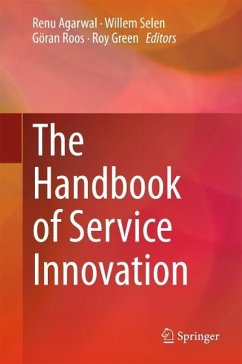Featuring cutting-edge research contributions, practical examples, implementations and a select number of case studies across several growth service industries, this book also includes examples of failed service innovation attempts in order to demonstrate a balanced view of the topic and to make clear the pitfalls to be avoided.
Culminating in a suggested step-by-step guide to enable service organization's managers to understand and implement the concepts of service innovation and manage its evolutionary processes effectively, this book will prove a valuable resource to a wide reaching audience including researchers, practitioners, managers, and students who aspire to create a deeper scientific foundation for service design and engineering, service experience and marketing, and service management and innovation.
Includes endorsements from professionals in the field of service innovation.
Dieser Download kann aus rechtlichen Gründen nur mit Rechnungsadresse in A, B, BG, CY, CZ, D, DK, EW, E, FIN, F, GR, HR, H, IRL, I, LT, L, LR, M, NL, PL, P, R, S, SLO, SK ausgeliefert werden.
Professor Andy Neely,
Director, Cambridge Service Alliance, University of Cambridge, UK.
This is a hugely important topic and this handbook containing chapters from some of the leading academics and practitioner in the field. Service innovation encapsulates much of the work on management practices and productivity. As the modern world increasingly focuses on services long-run growth is going to come from innovation in their delivery, both product and process innovation. This book provides an ideal map for researchers to get up to speed on the latest work and thinking.
Professor Nicholas Bloom,
Professor of Economics, Stanford University, California USA.
Senior Associate of the Centre for Economic Performance, London School of Economics, London, UK.
The nature of service innovation continues to evolve as service offerings dominate over product offerings in developed economies around the world. Today making sense of service innovation is a top priority in industry, academia, government, and the social sectors. The Handbook of Service Innovation provides a up-to-date set of concepts, examples, and perspectives on this intellectual deep and economic significantarea of research, practice, education, and policy.
Dr. James ("Jim") C. Spohrer
Director, IBM University Programs (IBM UP) and Cognitive Systems Institute
IBM Research - Almaden, San Jose, USA
The mechanisms by which services can innovate seem almost as numerous as the array of services themselves. And, the numbers of each are destined to grow as the percent of the workforce in service jobs continues to increase. The editors of this volume have ranged far and wide to provide us with some of the best current thinking on service innovation - how it happens, where it happens, and how it can be managed most appropriately. These articles illustrate the many ways in which services interact with our lives and the ways our lives interact with services - to change them and to improve them.
Professor Roger W. Schmenner,
Professor Emeritus of Operations Management, Kelley School of Business, Indiana University, USA
In this era of unparalleled service innovation, it is more vital than ever that we understand how to innovate and what makes service innovations successful. From high-tech services to hospitality to industrial and mass services, innovation is the key to competitive success, and this book is testimony to its importance and complexity. This collection of interesting new research provides many compelling insights and managerial prescriptions that should help both academic and practitioner audiences better appreciate the design, development, and management of service innovation, and improvement of service businesses and processes.
Professor Craig Froehle,
Professor, Operations & Business Analytics, University of Cincinnati, Ohio USA.
In many economies, the service sector accounts for the majority of economic value added today. And while services' economic importance is growing, the number of settings in which they are delivered is increasing as well. This means that no longer only pure service firms have to think about their capabilities for service innovation, but also government agencies and many industrial firms that are developing explicit service offerings and product service bundles. In addition, services are increasingly created and offered within complex networks and "eco-systems" - often across industry borders and applying advanced information and communication technology. This adds additional challenges and complexity for today's service managers. A key strength of the 'Handbook of Service Innovation' is its integration of numerous perspectives and backgrounds in the discussion of service innovation. Aspects covered include managerial challenges and capability building, the interplay of service innovation and technology, the roles of design and creativity, and collaborative innovation. This integrative and practice-oriented approach make the handbook an important asset for managers in any kind of service organisation.
Dr. Gerhard Satzger,
Director Karlsruhe Service Research Institute, Karlsruhe Institute of Technology (KIT), Englerstrasse, Karlsruhe Germany.
This Handbook deals with a most elusive yet real and important issue of innovation in services. It covers a wide array of issues and topical themes, not least open innovation, servitisation, frugal service innovation and co-creation. It looks at a wide variety of sectors in the private sphere but also at the public sector and Universities. It combines theory, practice, prescription, capability requirements and design. Despite its apparent diversity, the volume is coherent and well integrated. Overall this is quite impressive feat, in general and given the importance of services and intangible assets in today's semi-global economy, in particular. A must read for students, scholars and practitioners alike, the editors are to be congratulated for making this happen.
Professor Chris Pitelis,
University of Bath, and Queens' College, University of Cambridge, UK.
As a product developer, and as an educator of future product developers, I'm truly delighted to learn about the Handbook of Service Innovation. Service design and innovation aspects have become more and more important component of any new product development initiative. Without exception, our partners in manufacturing industry with B2B products are showing strong interest in services. The Handbook of Service Innovation will be warmly welcomed by a wide audience.
Professor Ekman Kalevi,
Director, Design Factory and Professor, Aalto University School of Science and Technology, Finland.
Services innovation is an important field of study. This Handbook contributes to the growing literature that explains innovation inservices, its nature, processes and outcomes.
Professor Mark Dodgson,
Director, Technology and Innovation Management Centre, University of Queensland Business School, Brisbane Australia.
This is a comprehensive and stimulating compilation devoted to service innovation. It gives an excellent overview of the current state of underpinning Service Innovation for global economy.
Professor Haluk Demirkan,
Professor of Digital Service Innovation & Business Analytics
Founder & Executive Director of Center for Information Based Management
Milgard School of Business, University of Washington - Tacoma, USA.
Co-Founder & Board of Director, International Society of Service Innovation Professionals (www.issip.org); Track Chair for Analytics, Mobile & Service Science at HICSS (www.hicss.hawaii.edu/).
The field of service innovation and services sciences is expanding at a rapid rate. The academic work and research is helping bringclarity to the new economic logic of a services based economy. This new logic is proving to be dramatically different from a product and consumption based economy. The Handbook of Service Innovation is an excellent collection of the latest thinking in the field. The diverse and cross-discipline nature of the topics covered in the handbooks reflects the expanding scope and breadth of service innovation.
Greg Oxton,
Executive Director, Consortium for Service Innovation, California USA.
The Australian Services Roundtable (ASR) applauds the creation of the Handbook of Service Innovation which provides a comprehensive update and set of insights around the very important issue of driving higher levels of innovative outcomes in the services economy. ASR notes that service industries account for 70% of world gross domestic product (GDP) and employ about 3.2 billion people. The detailed study of innovation in services has historically been lacking and this Handbook is a highly significant resource for private and public sector services professionals alike.
Services is ultimately a "people-to-people" endeavour and this important dimension is explored extensively in the Handbook. ASR is very pleased to endorse this important work and hopes that it provides a springboard for further research developments and improved outcomes.
Ian Birks, CEO, Australian Services Roundtable, Canberra, Australia.
The Handbook of ServiceInnovation is a must read for service managers and senior executives. It provides a comprehensive perspective on the challenge of service innovation. The book carefully addresses each aspect of service innovation. It addresses the true import of service innovation, provides an extensive literature review, identifies the skills and capabilities underpinning service innovation, explores governance and organizational structure that impinge on this challenge, and presents novel thinking on designing and managing service innovation. For the astute reader, this book will also open up new avenues for thinking about the application for service innovation thinking. The book spans organizational settings in both the public and private sectors, while also drawing on international experience.
Professor Aditya Ghose
FIEAust, President, Service Science Society of Australia, Director, Decision Systems Lab, School of Computer Science and Software Engineering, University of Wollongong, Wollongong, Australia.
Productivity growth in the service sector has lagged far behind manufacturing despite its growing dominance in terms of GDP and employment in a vast many of the leading national economies. It is well understood that the key to service productivity growth is innovation and new models of designing, implementing, and delivering services. This handbook of service innovation edited by Dr. Agarwal, and Professor Selen, Roos, and Green is put together in this spirit. It addresses a range of important themes that bear strongly on service innovation. These include open innovation and crowdsourcing,servitization, semantic and service web, sustainable and frugal service design, and creativity and community engagement, among others. The chapters in this volume taken together provide an original perspective on service innovation and offer useful guidelines for promoting greater innovativeness at every stage of the service life cycle.
Professor Joseph G. Davis,
Professor of Information Systems and Services, The University of Sydney, Sydney Australia.
In this book, Agarwal, Selen, Roos and Green present a breadth of diverse topics necessary to gain practical insight into designing, managing and growing complex innovative services that benefits businesses and society. Drawing on latest research, and best practices, The Handbook of Service Innovation is a must read for those seeking to learn more about skills and capabilities needed to stay competitive in our growing service economy in the 21st century.
Yassi Moghaddam,
Executive Director, International Society of Service Innovation Professionals, California USA.









